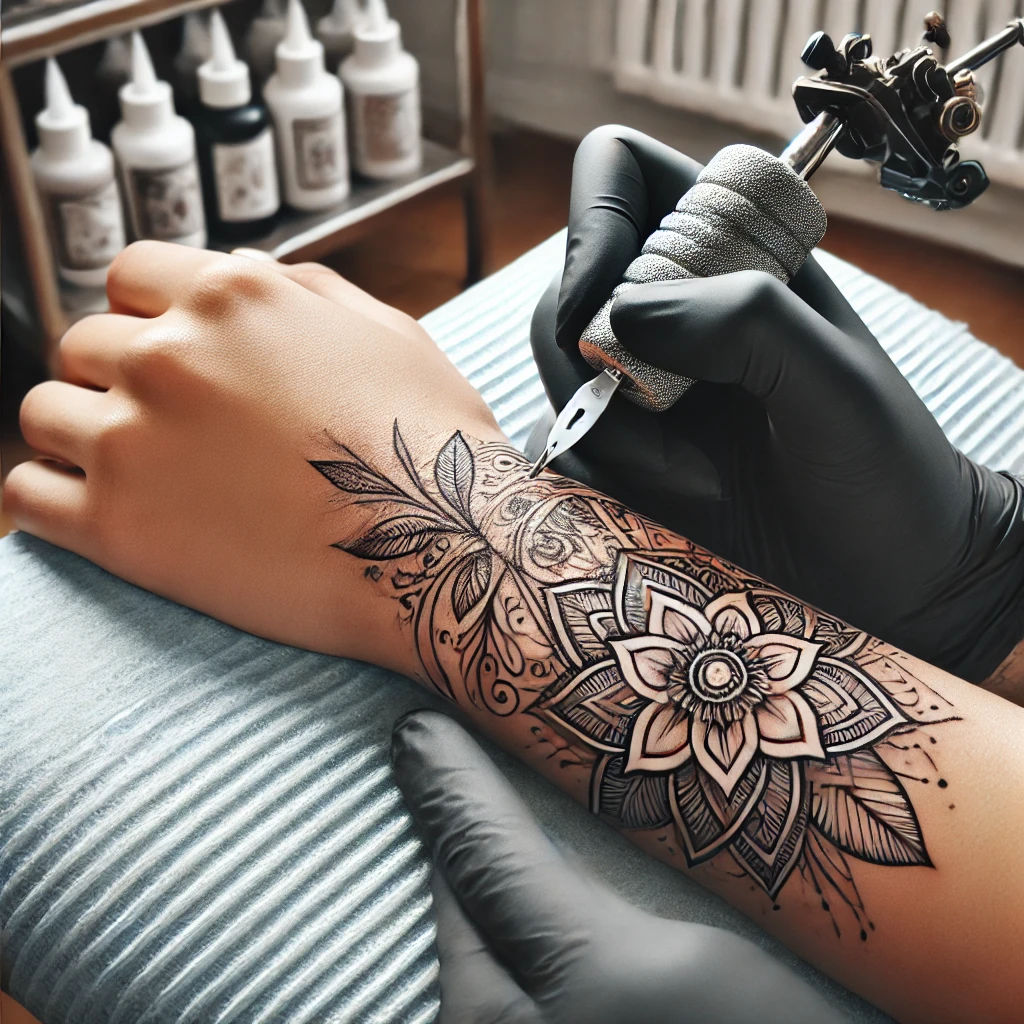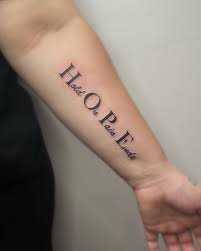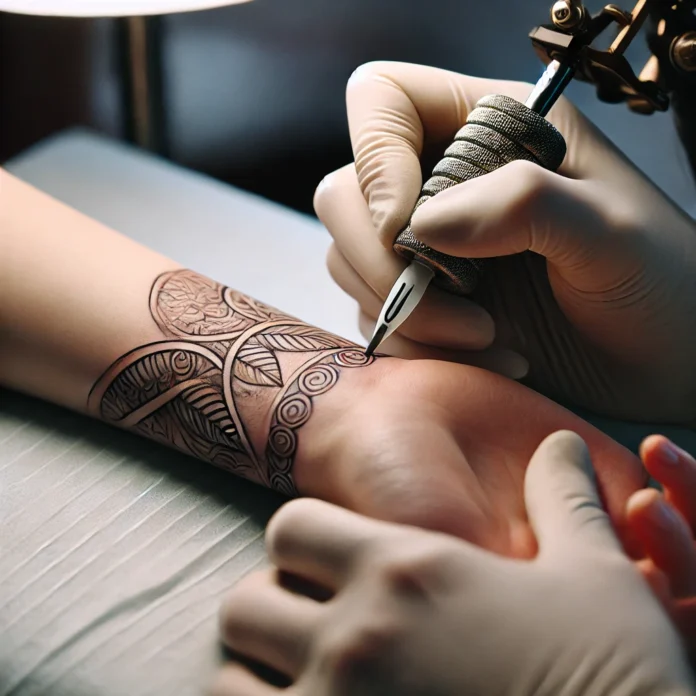When it comes to getting wrist tattoos, the reputation for being super painful might make you wonder: how bad can it really be? Turns out, several factors come into play that can make the pain feel better or worse. The wrist is a popular spot for tattoos, but the thin skin and proximity to bones often raise questions about discomfort.
Whether you’re preparing for your first tattoo or adding to your collection, understanding the lowdown on wrist tattoo care, choosing the best studio, and knowing what to expect will make the process smoother. Keep reading for the real answers to whether wrist tattoos truly hurt as much as people say.
How Much Do Wrist Tattoos Hurt?
Getting a wrist tattoo is a bold choice, but let’s not sugarcoat it—any tattoo is going to hurt to some extent. When it comes to wrist tattoo pain, it’s definitely higher compared to other body parts like arms or thighs, but maybe not as intense as nerve-rich areas like nipples or lips. From what most people say, the discomfort varies widely, ranking anywhere from a manageable “5 out of 10” to a dramatic “what-was-I-thinking” moment. But here’s the thing: pain is deeply subjective—everyone’s experience is different.
That said, tattoos rarely feel great, and a wrist tattoo is no exception. As Karabudak points out, areas closer to the bone or joints are often more painful. For instance, while the chest or ribs might top the pain chart at a solid 10, the wrist usually hovers around a 2 to 4, depending on spots like the side near the palm. Ultimately, understanding your own threshold for discomfort can help you decide whether a wrist tattoo is the right move for you.
Placement Is Important For Wrist Tattoo
Pain intensity with wrist tattoos depends heavily on the areas you choose. Spots with more nerves, less flesh, and closer proximity to bone tend to hurt the most. The inner wrist, especially near the palm, is highly sensitive, partly due to the palmar cutaneous branch of the median nerve that sends signals between the central nervous system and the hand. This sensitivity explains why this region can feel more discomfort, as even subtle movements of the tattoo needle can heighten the pain. In one case, an inner wrist tattoo even led to hyperalgesia, which is a heightened reaction to pain.

The outer wrist also has its challenges, particularly over the wrist bone (ulna). The vibration from the tattoo needle against the bone creates a vibrating pain, which, while not overwhelmingly intense, is still noticeable. Areas with less fat over the bone amplify this sensation. On the other hand, the sides of the wrist are less painful, with the pain diminishing as you move towards the forearm.
How long does the pain last?
The intensity of pain during a wrist tattoo can vary throughout the process, depending on what the tattoo artist is doing. For instance, using a single needle for fine details may feel different from repeatedly working over the same spot to fill in color.
Once the tattoo is finished, the pain stops, leaving only mild soreness for about 1 to 2 weeks as the skin gradually heals. A properly healed tattoo shouldn’t cause any further pain, but if discomfort persists or worsens, it could indicate an infection or an allergic reaction, which needs immediate attention.
Pain Relief Tips For Wrist Tattoo
Getting a wrist tattoo can be uncomfortable, but there are ways to manage the pain effectively. Here are some helpful tips:
- Stay Hydrated: Drink plenty of water before your appointment to keep your skin hydrated and better prepared for the tattoo process.
- Eat a Balanced Meal: Ensure you eat a healthy, filling meal beforehand to maintain your energy and avoid lightheadedness during the session.
- Use Numbing Cream: Apply a tattoo-safe numbing cream to the area before the session, as advised by your tattoo artist.
- Take Breaks: If the pain becomes too intense, ask your artist for short breaks to relax.
- Focus on Breathing: Deep, steady breathing can help you stay calm and reduce discomfort.
- Distract Yourself: Bring headphones and listen to music or a podcast to take your mind off the pain.
- Avoid Alcohol or Caffeine: These can thin your blood, making the tattoo process more painful and messy.
- Wear Comfortable Clothing: Make sure the area around your wrist is accessible and doesn’t feel restricted.
- Aftercare is Key: Follow proper aftercare to minimize pain and speed up healing. Keep the tattoo clean, moisturized, and avoid touching it unnecessarily.
By following these tips, you can make your wrist tattoo experience more manageable and enjoy the results with less discomfort.
Signs of a problem For Wrist Tattoos
No tattoo is completely pain-free, and mild soreness, itching, and crusting are normal as your skin heals. However, if you notice anything beyond that—such as worsening discomfort, signs of an infection, or an allergic reaction—it’s important to consult a healthcare professional promptly.
Consult a healthcare professional if you notice any of these symptoms.
- severe or worsening pain
- swelling
- itchy, painful rash or blisters over the tattoo
- severe redness or redness that spreads out from the tattoo
- smelly discharge or pus from the tattoo
- open sores
- fever
- muscle aches
Wrist Tattoo Aftercare Tips
While each tattoo artist may provide specific aftercare instructions, the essential steps remain consistent. Keep the tattoo clean with gentle soap, avoid itching or picking at it during the healing process, and keep the area moisturized. Don’t forget to apply SPF generously, as a wrist tattoo is often exposed to the sun.

Because of the high-motion nature of the wrist, extra care is needed. Monitor how often the tattooed area comes into contact with surfaces and try to minimize unnecessary contact or flexing. According to Karabudak, areas like the wrist are more prone to abrasion and potential infection due to constant movement and friction.
How Much Does It Cost?
The cost of a wrist tattoo can vary depending on several factors, including the tattoo artist’s experience, the design’s complexity, and the studio’s location. On average, a small and simple wrist tattoo might cost anywhere between $50 and $200. However, more detailed designs or sessions with a renowned artist can increase the price significantly, sometimes reaching $500 or more. Always remember that quality is worth the investment, especially for something as permanent as a tattoo.
Conclusion
While wrist tattoos can be more painful than some other areas, the discomfort is manageable with proper care and preparation. Understanding the healing process, following aftercare tips, and knowing what to expect in terms of pain will help ensure a smooth tattoo experience. Whether you’re drawn to the design or the personal significance, a wrist tattoo can be a meaningful and rewarding choice.
Frequently Asked Questions
1. How painful is a wrist tattoo compared to other body parts?
Wrist tattoos are generally more painful than areas with more flesh, like the arms or thighs, but not as intense as nerve-rich spots like the nipples or lips. The pain varies based on the individual’s tolerance, but it tends to be manageable.
2. How long does it take for a wrist tattoo to heal?
A wrist tattoo typically takes 1 to 2 weeks to heal, though mild soreness may last a bit longer. Proper aftercare, such as keeping the area clean and moisturized, will help speed up the healing process.
3. Can I prevent infection after getting a wrist tattoo?
Yes, following proper aftercare guidelines—like keeping the tattoo clean, avoiding itching, and applying SPF—can significantly reduce the risk of infection. If you notice any unusual symptoms, such as increased pain, swelling, or redness, consult a healthcare professional immediately.
